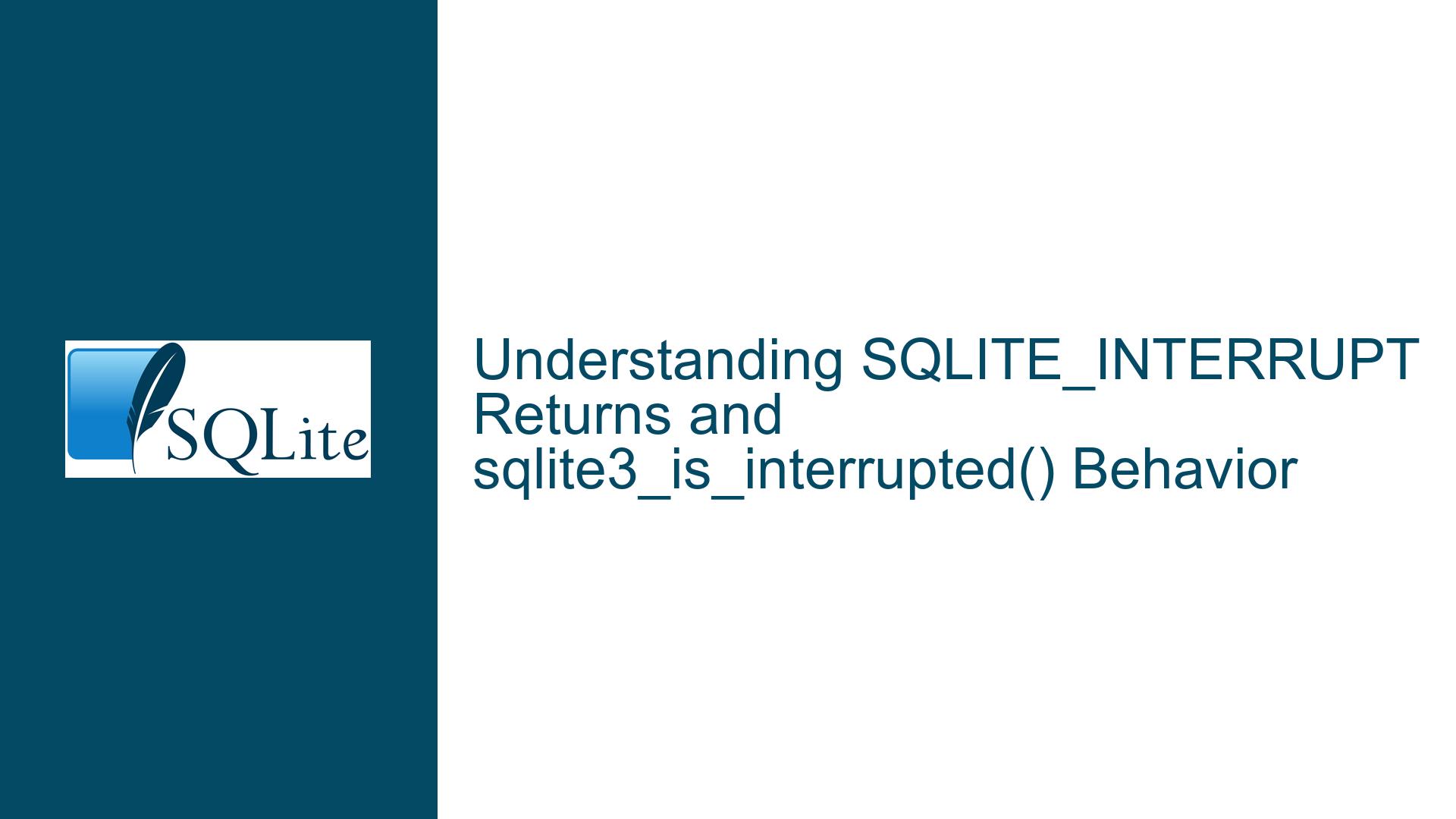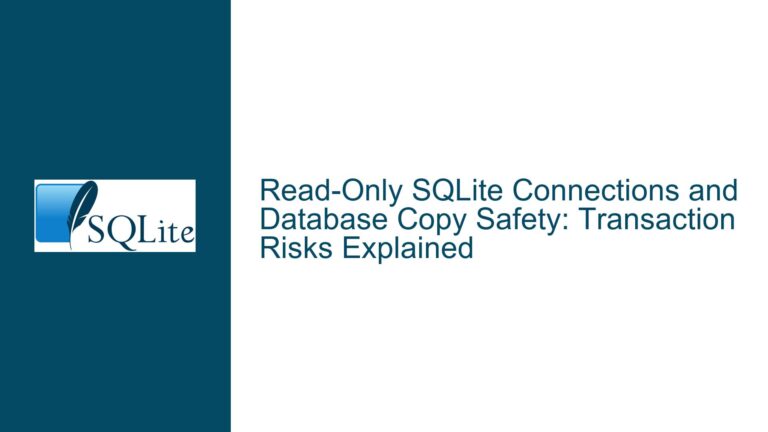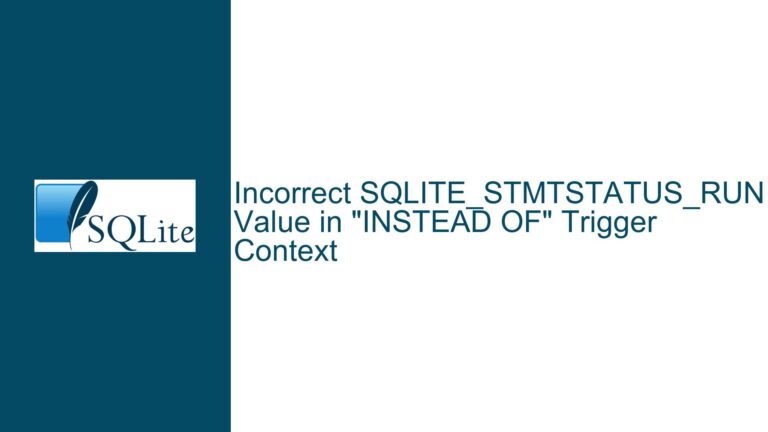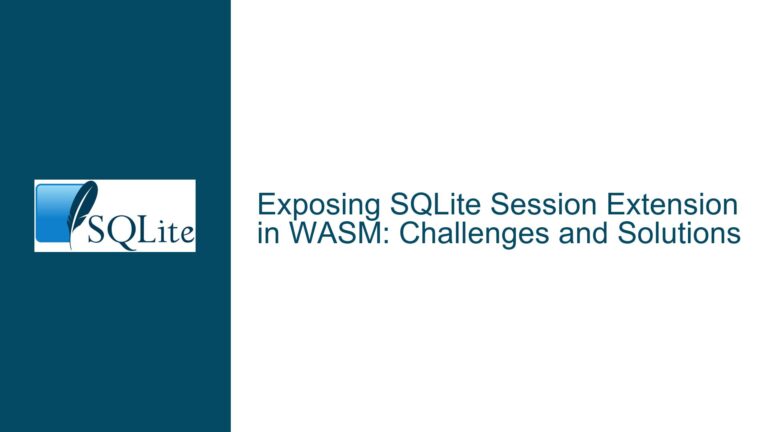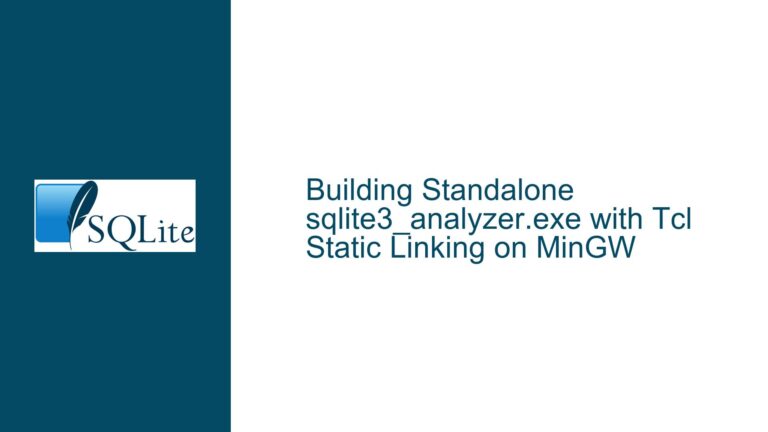SQLITE_INTERRUPT Returns and sqlite3_is_interrupted() Behavior
Core Mechanism of Asynchronous Operation Interruption
SQLITE_INTERRUPT Signal Propagation in API Operations
The SQLITE_INTERRUPT error code plays a critical role in managing long-running database operations. When sqlite3_interrupt(sqlite3*) is invoked, it sets an internal flag within the SQLite database connection object. This flag does not immediately halt execution but instead causes subsequent checks during query processing to return SQLITE_INTERRUPT. The key nuance lies in understanding which API functions respond to this flag and under what circumstances.
All SQLite API functions that execute SQL statements – including sqlite3_step(), sqlite3_exec(), and sqlite3_prepare_v2() variants – contain periodic checks for the interrupt flag. For example, during a SELECT query processing billions of rows via repeated sqlite3_step() calls, each iteration between row productions will verify the interrupt status. If set during any of these checks, the current sqlite3_step() invocation returns SQLITE_INTERRUPT immediately, abandoning further processing.
This design creates specific behavioral patterns:
- Granularity of Interrupt Checks: SQLite performs interrupt checks at natural breakpoints in query execution, such as between individual opcode executions in the virtual machine or when allocating new database pages. Operations without such breakpoints (e.g., memory-copying loops) may delay interrupt recognition.
- State Preservation: When interrupted, the database connection remains open with active transaction state preserved. This allows applications to decide whether to commit, rollback, or retry operations after handling the interruption.
- Thread Safety Considerations: While
sqlite3_interrupt()is thread-safe, its effects become visible to the connection-handling thread only during the next interrupt check. Applications must coordinate interrupt timing with query execution phases to ensure responsiveness.
A practical demonstration involves executing a computationally intensive query:
sqlite3 *db;
sqlite3_open(":memory:", &db);
sqlite3_exec(db, "WITH RECURSIVE cte(x) AS (VALUES(1) UNION ALL SELECT x+1 FROM cte) SELECT COUNT(*) FROM cte;", NULL, NULL, NULL);
While this query runs (theorizing an infinite recursion), invoking sqlite3_interrupt(db) from another thread forces sqlite3_exec() to return SQLITE_INTERRUPT, terminating the query. The critical observation is that interruption effectiveness depends on SQLite’s internal check frequency within the executing operation.
Misconceptions About Immediate Cancellation
Expectation Mismatch in Interrupt Latency
A common source of confusion stems from assuming sqlite3_interrupt() provides instantaneous query termination. In reality, the interrupt flag acts as a cooperative cancellation mechanism rather than a preemptive one. SQLite operations will continue until they reach the next interrupt check point, which varies by operation type:
- Data Retrieval Operations:
SELECTqueries processing large result sets check for interrupts between individual row retrievals. ALIMIT/OFFSETclause with large offsets demonstrates this well:
SELECT * FROM large_table LIMIT 1 OFFSET 1000000000;
Each skipped row during OFFSET processing represents a potential interrupt check point. Pressing Ctrl-C in the SQLite CLI during this query triggers sqlite3_interrupt(), causing the next check to return SQLITE_INTERRUPT.
Data Modification Operations:
INSERT,UPDATE, andDELETEstatements with WHERE clauses may check interrupts more frequently due to index traversals and page allocations. Bulk operations without WHERE filters might exhibit longer latency due to optimized full-table scans.Transaction Control:
BEGIN IMMEDIATEandCOMMIToperations contain interrupt checks during lock acquisition phases. An interruptedCOMMITleaves the transaction active, requiring explicit rollback.
The sqlite3_is_interrupted(sqlite3*) function provides direct access to the current interrupt flag state, returning 1 (true) or 0 (false). This allows applications to implement custom polling mechanisms:
while(sqlite3_step(stmt) == SQLITE_ROW) {
if(sqlite3_is_interrupted(db)) {
// Custom cleanup before official interruption
break;
}
// Process row
}
However, relying solely on sqlite3_is_interrupted() without coordinating with SQLite’s internal state management can lead to race conditions. The flag gets automatically reset when an operation returns SQLITE_INTERRUPT, making subsequent calls to sqlite3_is_interrupted() return 0 until another interrupt is requested.
Strategic Handling of Asynchronous Termination
Implementing Robust Interrupt-Aware Database Logic
Effective use of SQLite’s interruption capabilities requires understanding three key phases: interrupt triggering, error handling, and connection state recovery.
Phase 1: Interrupt Triggering
- Thread Coordination: Designate a dedicated thread for invoking
sqlite3_interrupt(), ensuring it targets the correct database connection handle. Cross-thread handle sharing must follow SQLite’s threading mode constraints (SERIALIZED vs MULTITHREAD). - Signal Handling: In UNIX-like environments, map OS signals (SIGINT) to interrupt calls:
void sigint_handler(int sig) {
sqlite3_interrupt(g_db_handle);
}
signal(SIGINT, sigint_handler);
- Timeout Integration: Combine interrupts with
sqlite3_busy_timeout()for automated interruption after specified durations, though this affects different error conditions (SQLITE_BUSY vs SQLITE_INTERRUPT).
Phase 2: Error Handling
All database operations must check return codes for SQLITE_INTERRUPT:
int rc = sqlite3_step(stmt);
if(rc == SQLITE_INTERRUPT) {
// Handle interruption
sqlite3_reset(stmt); // Required before reusing prepared statement
}
Critical considerations include:
- Transaction State: Interrupted commits leave transactions open. Check
sqlite3_get_autocommit()to determine if a transaction remains active. - Statement Reset: Failing to reset interrupted statements leaves them in a need-reset state, blocking future operations until resolved.
- Resource Cleanup: Open BLOB handles, backup operations, and virtual table cursors require explicit closure despite interruptions.
Phase 3: Connection Recovery
After interruption, connections may require resetting:
- Transaction Rollback: Explicitly rollback any interrupted transactions.
- Statement Finalization: Either reset prepared statements with
sqlite3_reset()or fully finalize them. - Schema Revalidation: In rare cases where interrupts occur during schema changes, verify schema integrity with
PRAGMA quick_check.
Advanced techniques involve wrapping operations in savepoints for partial rollbacks:
SAVEPOINT before_operation;
-- Execute interruptible operation
RELEASE before_operation;
If interrupted, rollback to the savepoint preserves prior state:
if(rc == SQLITE_INTERRUPT) {
sqlite3_exec(db, "ROLLBACK TO before_operation;", 0, 0, 0);
}
Performance Optimization and Debugging Techniques
Balancing Responsiveness with Operational Efficiency
While frequent interrupt checks improve cancellation responsiveness, they impose performance overhead. SQLite allows tuning this balance through compile-time options and runtime practices:
- SQLITE_OMIT_INTERRUPT: Disabling interrupt checks entirely (not recommended for interactive applications) removes overhead but eliminates cancellation support.
- Custom Check Frequency: Modifying the SQLite source to alter the number of virtual machine instructions between interrupt checks (search for
db->u1.isInterrupted). - Progress Handlers: Use
sqlite3_progress_handler()to invoke custom callbacks at regular intervals, which can check external cancellation flags:
sqlite3_progress_handler(db, 1000, my_progress_handler, NULL);
The handler fires after approximately every N virtual machine operations (1000 in this example), allowing custom interruption logic without modifying SQLite internals.
Debugging interrupt-related issues requires:
- Logging Interrupt Invocations: Track
sqlite3_interrupt()calls with thread IDs and timestamps. - Core Dump Analysis: Use debugging tools to inspect the
sqlite3structure’su1.isInterruptedfield during crashes. - Query Plan Inspection:
EXPLAINoutput reveals potential long-running operations without interrupt checks. Look for loops in the bytecode.
Example diagnostic workflow:
- Reproduce the issue with a minimal test case.
- Enable SQLite’s error logging:
sqlite3_config(SQLITE_CONFIG_LOG, error_log_callback, NULL);
- Attach a debugger and set breakpoints on
sqlite3_interrupt()andsqlite3VdbeCheckInterrupt(). - Analyze the call stack when breaks occur to identify missing interrupt checks.
By methodically applying these principles, developers can implement responsive, robust database operations that gracefully handle user cancellations while maintaining data integrity and performance.
